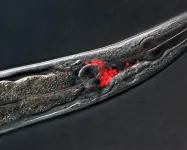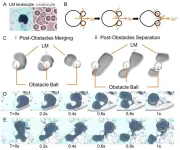(Press-News.org)
A team of researchers from the Sant Pau Research Institute (IR Sant Pau) has published a study in the Journal of Neuroinflammation that, for the first time, examines in depth the role of the peripheral immune system in amyotrophic lateral sclerosis (ALS) at the single-cell level. Their findings suggest that immune system cells—particularly two subpopulations of Natural Killer (NK) cells—may play a crucial part in the development and progression of this neurodegenerative disease.
ALS is a condition that causes the progressive degeneration of motor neurones, leading to a loss of muscle function and, eventually, affecting vital functions such as breathing. At present, there is still no curative treatment or sufficiently effective therapy to halt its progression, and the estimated average survival after diagnosis is between 3 and 5 years.
First detailed analysis of the immune system in ALS
Although the role of the immune system had already been demonstrated in diseases such as Alzheimer’s, until now, there had not been a similarly in-depth study confirming this significance for ALS. “It was suspected that there could be an immunological component involved in the disease, but it had not been demonstrated in depth at the cellular level,” explains Dr Oriol Dols, a researcher in the Neurobiology of Dementias group and Memory Unit at IR Sant Pau, who coordinated the study.
To address this challenge, 14 patients with sporadic ALS—i.e. with no known genetic mutations explaining the condition (around 90% of ALS cases)—were recruited and their immune profile compared with that of 14 healthy individuals who served as a control group.
Using single-cell RNA sequencing—a technique that allows researchers to analyse gene expression in individual cells—the scientists were able to study over 100,000 immune cells from peripheral blood one by one, detecting highly specific cellular and genetic alterations in each subpopulation of lymphocytes, monocytes and, notably, NK cells.
Altered NK cell subpopulations
NK cells are primarily known for their role in defending against viral infections or tumour cells. However, this study showed an abnormal increase in certain subpopulations of NK cells in ALS patients, which also presented a hyperactivated state.
“The key finding is that not only are NK cells increased overall, but there are two very specific subpopulations with different implications,” notes Dr Dols. One of these subpopulations appears to exert a modulatory effect on other immune cells, such as CD8 or CD4 T lymphocytes; the other is closely associated with neurodegenerative processes, as evidenced by a connection with neurofilament levels, a marker of neuronal damage. “This suggests that these NK cells might directly influence motor neurone injury,” adds the specialist.
Changes also in monocytes and T lymphocytes
In addition to NK cells, the study reveals alterations in subpopulations of monocytes and CD8 T lymphocytes with an increased capacity for antigen presentation. Altogether, this indicates a global immune system imbalance that may contribute to a neuroinflammatory environment and speed up the death of motor neurones.
“Knowing that the peripheral immune system is involved in ALS opens up new lines of inquiry: from the search for blood biomarkers to facilitate earlier diagnosis, to prospective therapies targeting these specific subpopulations,” says Esther Álvarez-Sánchez, also a researcher in the Neurobiology of Dementias group and Memory Unit at IR Sant Pau, and first author of the article.
At present, there is no approved drug that specifically modulates NK cells or T lymphocytes in the context of ALS, so these findings represent an initial step towards developing more targeted and combined treatments.
Next steps and impact
This study was carried out with the largest cohort so far analysed by single-cell RNA sequencing in ALS (14 patients and 14 controls). The statistical outcomes confirm the robustness of the immune differences detected, and the team is already conducting a longitudinal follow-up of the same patients one year later to gauge how the immune profile evolves.
Likewise, in vitro experiments are being designed to combine patients’ NK cells with motor neurones, to decipher which specific signals trigger the hyperactivation of these subpopulations and how they relate to neuronal death. “Understanding the mechanism that drives part of the immune system to become ‘uncontrolled’ is essential, and we must also explore how to modulate it without impairing the beneficial functions of these cells,” explains Dr Dols.
Although this work does not immediately translate into a treatment, the identification of key immune subpopulations in ALS is a promising step forward. “Just as in cancer we have learned to regulate the immune response to combat tumours, in ALS we are moving towards the idea of combining therapies addressing both neurodegeneration and the altered immune response,” concludes Dr Dols.
END
A UCLA Health research team has identified changes in brain rhythms that indicate seizure activity in Alzheimer’s patients.
The findings, published in Brain Communications, build on UCLA neurologist and senior author Dr. Keith Vossel’s pioneering work that first linked silent epileptic activity to cognitive decline in Alzheimer’s disease.
Vossel’s previous studies showed that silent seizures, detected through overnight electroencephalography (EEG) and one-hour magnetoencephalography (MEG), occur in more than 40% of Alzheimer’s patients—beyond the 20% who experience overt seizures. His research has demonstrated ...
Hydrogels are polymeric materials with three-dimensional network structures containing large amounts of water. They serve as sustained-release drug delivery systems as they can encapsulate various bioactive substances, including drugs, antigens, and even cells. Hydrogels are better drug delivery alternatives than conventional systems, as they are more biocompatible, biodegradable, and easily administered as an injectable scaffold.
DNA has gained significant attention as a promising hydrogel material thanks to its customizable physicochemical properties, leading to the development of various DNA ...
Paramedics in England are experiencing wide-ranging challenges in responding to the increasing number of end-of-life care patients they are being called out to, according to a study from the University of Southampton.
The study published in BMC Palliative Care highlights the issues paramedics face when responding to patients at end-of-life, including a lack of patient information, barriers to administering medication, and insufficient training.
It was funded by Marie Curie and supported by National Institute for Health and Care Research (NIHR) Applied ...
A study of nematodes by researchers at Nagoya University in Japan has found that aging-related decline in brain function is caused by the excessive activation of certain neurons over time, rather than a decline in neuronal activity. This finding, published in the journal Proceedings of the National Academy of Sciences, suggests that interventions aimed at reducing neuronal hyperactivation, such as dietary changes, could potentially mitigate age-related cognitive decline.
Proper brain function occurs when a large number of neurons are connected to each other and work ...
Osaka, Japan – From disaster zones to extreme environments, there remain areas difficult for even humans to reliably access. This poses a problem for search-and-rescue operations, research, surveillance, and more. Now, however, a research team from Osaka University and Diponegoro University, Indonesia is hard at work on one potential solution: the cyborg insect.
Cyborg insects have a lot of advantages over traditional robots. Power consumption is less of an issue, so it’s easier to miniaturize them, and they are even ‘pre-built’ in a sense. However, research on cyborg insects has been limited to simple environments, like flat surfaces supplemented ...
New research from the University of Sydney has found people tend to discriminate in favour of individuals who show a similarity to them, even when the similarity arises from a random event like the flip of a coin.
Published in Proceedings of the National Academy of Sciences, the research runs counter to traditional theories, in particular social identity theory, that assume discrimination occurs because we divide people into groups. It finds, instead, differences between individuals are enough to trigger discrimination.
Previous research (using the seminal ‘minimal group’ experiment) showed participants tend to financially benefit members of their own group over ...
As solar energy plays an increasing role in the global power supply, ensuring accurate forecasts of photovoltaic (PV) power generation is critical for balancing energy demand and supply. A new study published in Advances in Atmospheric Sciences explores how machine learning and statistical techniques can refine these forecasts by correcting errors in weather models.
Weather forecasts are a key input for PV power prediction models, yet they often contain systematic errors that impact accuracy. Researchers from the Institute of Statistics at the Karlsruhe Institute of Technology ...
Scientists led by Prof. LIU Jing from the Technical Institute of Physics and Chemistry of the Chinese Academy of Sciences (CAS) have created a leukocyte-like liquid metallic entity that vividly simulates various leukocyte behaviors in nature.
Published in Matter on February 10, the researchers demonstrated how these "liquid metallic leukocytes" can autonomously perform complex actions like engulfing foreign substances, changing shape, moving in a pulsatile manner, and even climbing against gravity—showing striking similarities to the dynamic behavior of living cells.
The research ...
RICHLAND, Wash.—Curled up inside every single one of the trillions of cells in the human body is six feet of DNA, spooled tightly and carrying the genetic instructions that govern so much of who a person becomes. It’s a nicely wrapped package of instructions for a lifetime.
But having the package in hand is a far cry from understanding how it’s executed.
It’s been 20 years since scientists completed the Human Genome Project, sequencing the entire length of DNA found in a person. Scientists have now done the same with an amazing array of organisms, including some types of worms, mice, mosquitoes, fruit flies, trees, rice and pufferfish.
Science ...
Researchers at Flinders University say there is an urgent need to encourage more girls to participate in sports, following a new study that reveals a striking lack of research on girls' sport engagement.
A new study in Sport in Society journal set out to review existing data on interventions to engage female adolescents in organised sport, and to explore the different factors that influence their experience and decision making in sport.
“Despite a rigorous systematic search of more than 3,000 articles, only five (globally) were found to ...







